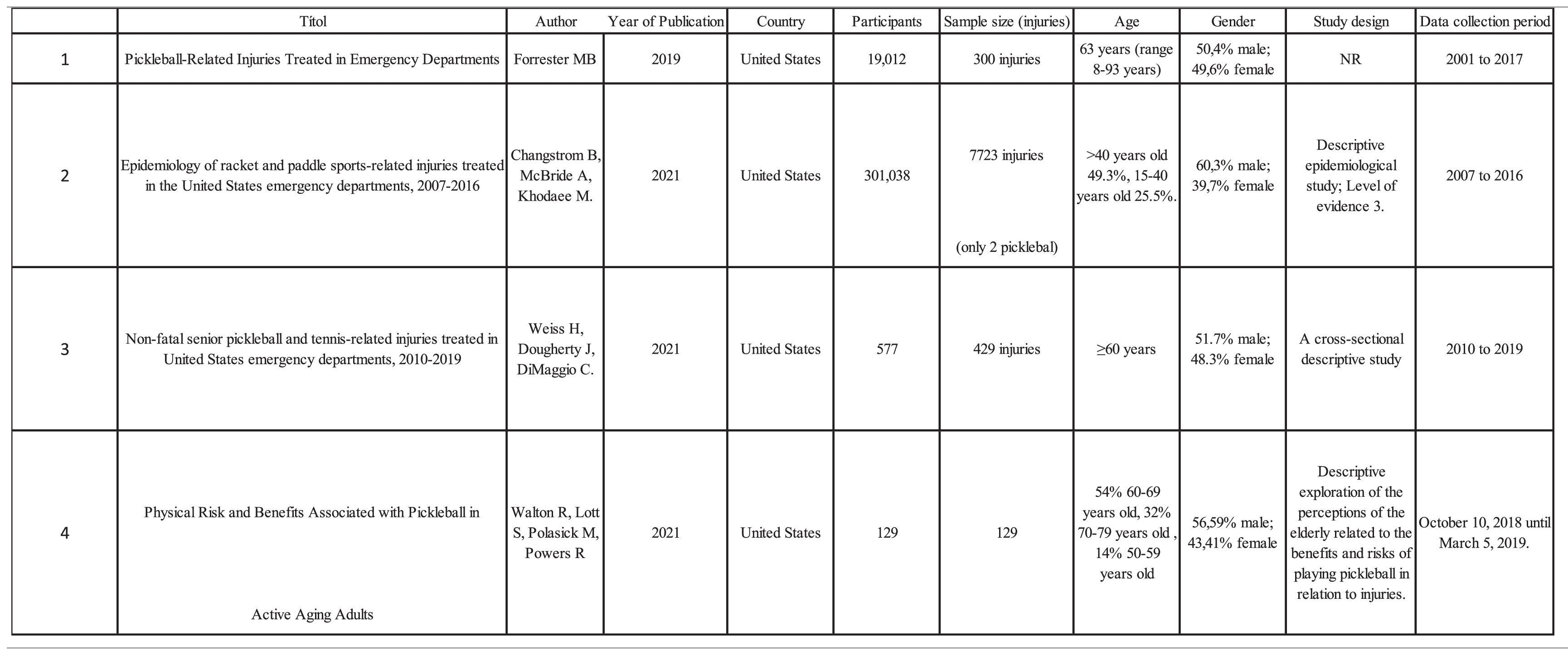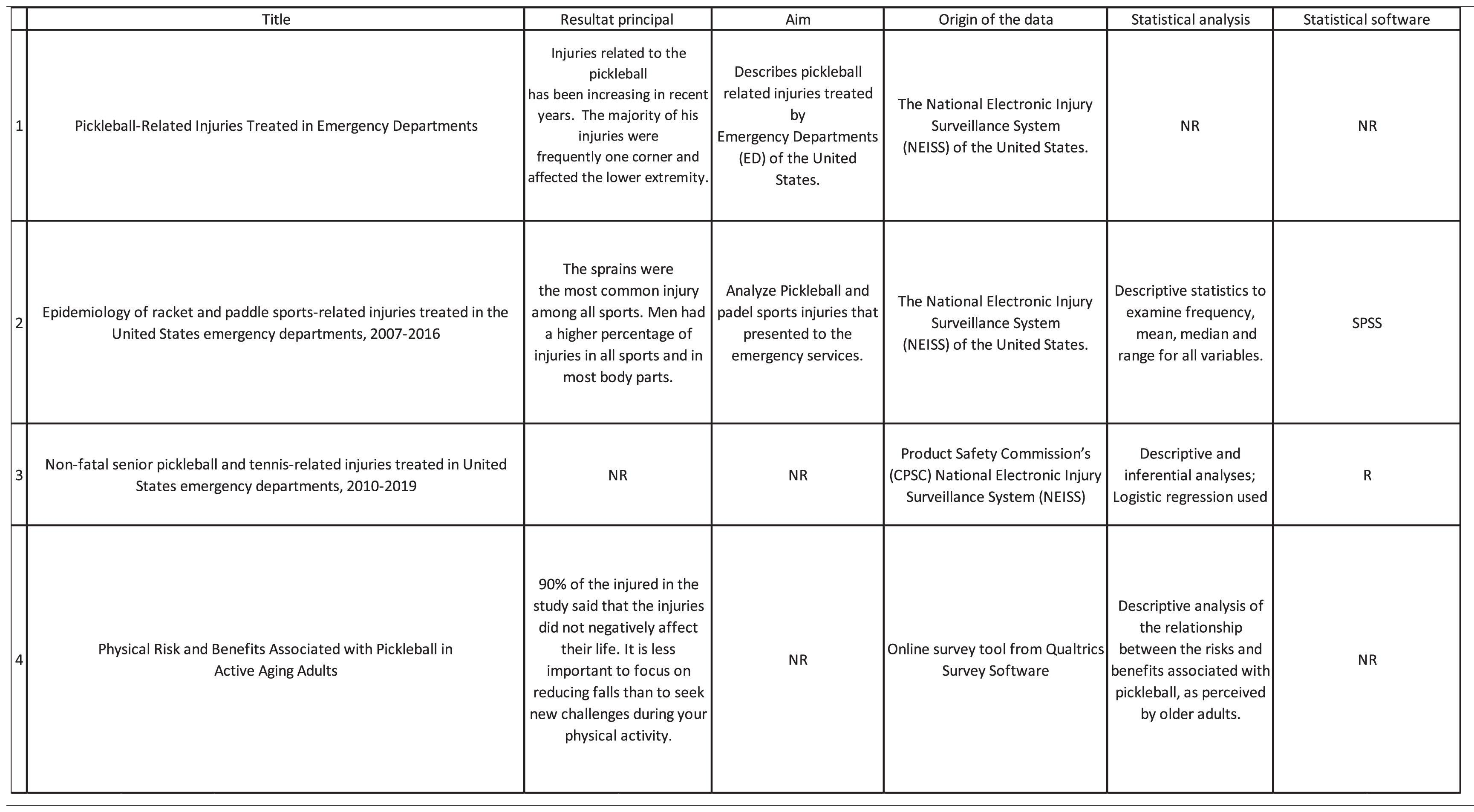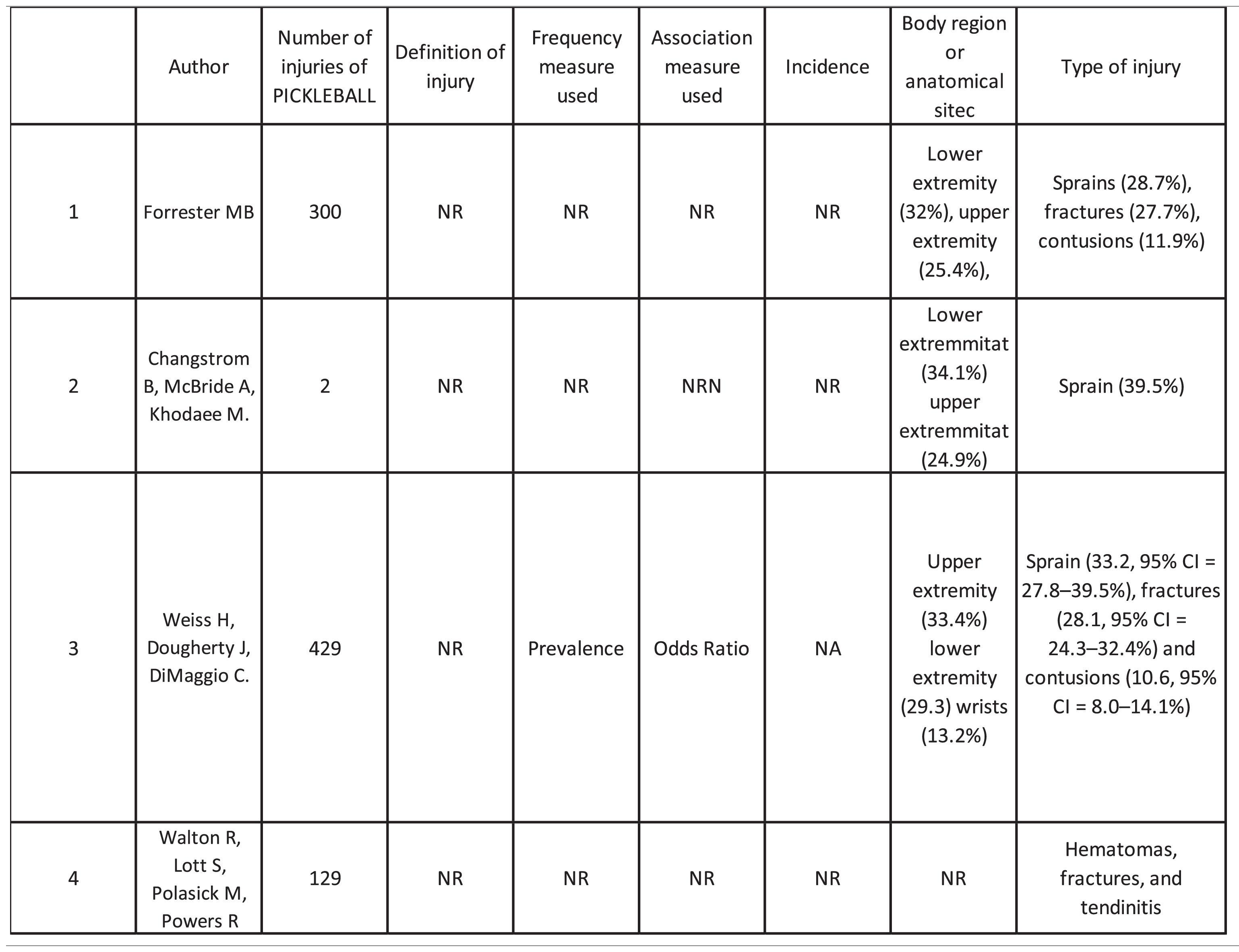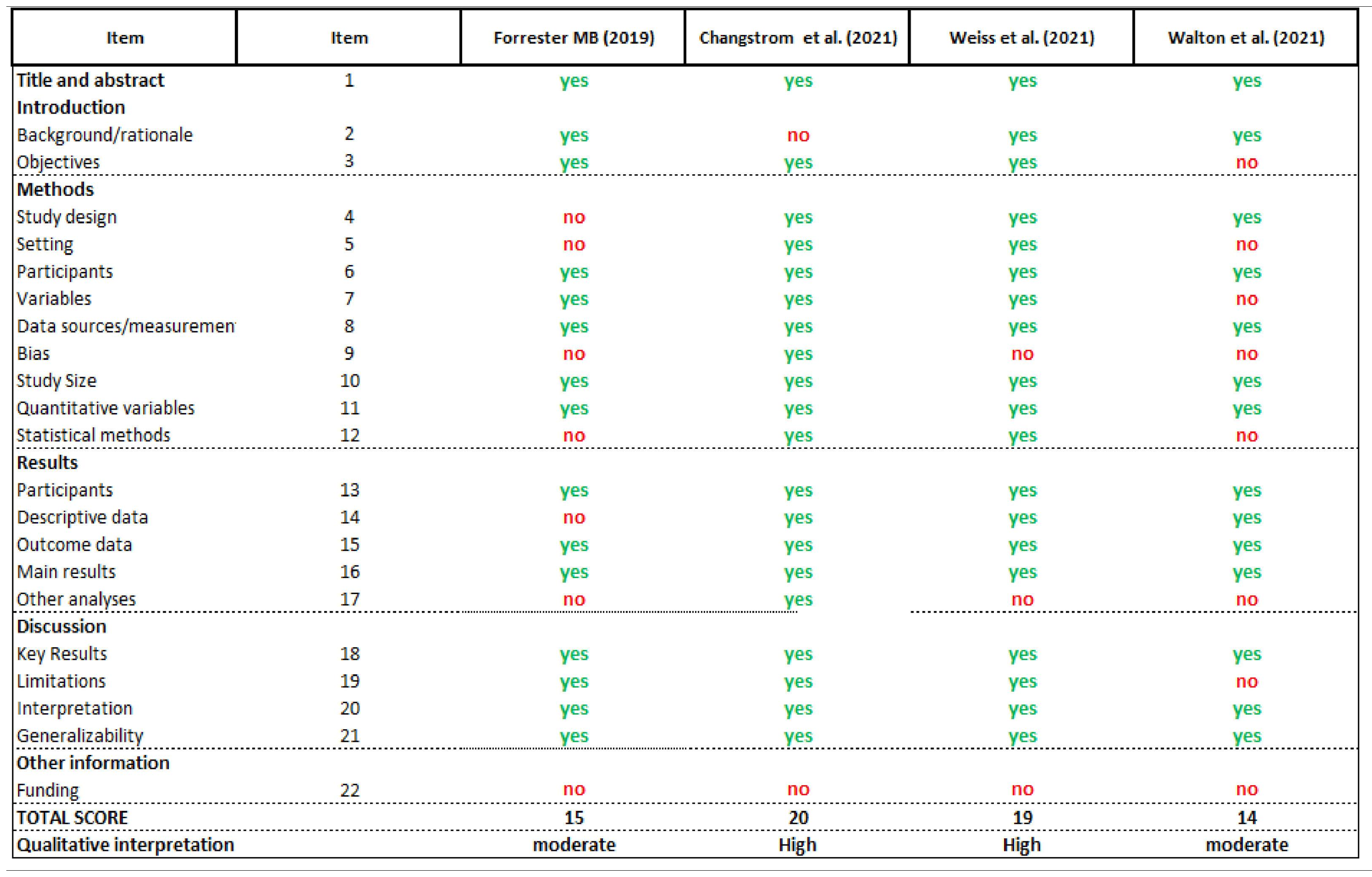Pickleball is a sport that combines several elements of tennis, badminton and table tennis. It is played on a court similar to the badminton court and the objective of the game is to hit the ball over a net similar to the tennis net. During these years, its popularity has grown substantially in the United States of America and it has been a sport played by people of different ages. It is important to know the different injuries that can occur in this sport in order to prevent and treat them. The aim is to perform a scoping review following the PRISMA-SCR guidelines to identify the main health problems and injury characteristics suffered in pickleball athletes. A total of 4 articles from different databases were found based on the keywords and boolean operators: ("Pickleball") AND ("injury" OR "injuries" OR "pathology*" OR "illness*" OR " disease*"). The most common injuries that occur are sprains and strains, and they tend to belong to the old age. However, more epidemiological studies about pickleball injuries are needed. Few studies have been found where the data sources show limitations to subsequently be able to carry out epidemiological studies with more precision. Even so, the scientific evidence is limited to provide applicable and conclusive results and more studies are needed on this topic in pickleball.
Pickleball was born in 1965 and was created by Joe Pritchard, Bill Bell and Barney McCallum on Brainbrige Island, Washington. It is a racquet sport that incorporates aspects of tennis, badminton, wiffleball and table tennis.1 It is normally played on a hard court measuring 20×44 feet (6,096×13,411 meters) with a net at the middle. The rules of pickleball are simple, it can be played both individually and in doubles and due to its characteristics, it is indicated for all age groups. The game starts in the same way as badminton, with a serve from below and then becomes similar to tennis. Points can only be scored by the team that wins the game or if the opposing team commits a foul. As a general rule, the team who first scores 11 points is the one that wins the game. Whoever wins the point, serves. A difference of two points is needed to win the game. The higher the level of the participants, the faster and more dynamic the game is.2
Currently, according to the World Pickleball Federation (https://www.worldpickleballfederation.org/), pickleball is played in all continents of the world except Africa. There are currently 29 national pickleball federations spread around the world. According to Sports, Fitness & Leisure Activities (SFIA; https://sfia.org/), pickleball is the sport that has grown the most in these two consecutive years, up 39.3%, and has a total of 4.8 million participants in the United States of America (USA). To a great extent, this growth could be due to the fact that in this sport it is relatively easy to learn the basic technical skills to play. This fact allows players to feel skilled from the beginning, encouraging them to continue participating and playing.3
In different sports and also in racquet sports such as tennis or lacrosse, injury prevention has been studied taking into account their internal and external load.4,5 The discrepancy between tennis and pickleball is the modality of play. In tennis both the serves and the play close to the net is played fundamentally above the shoulder, while in pickleball and following the corresponding regulations, the whole game is played below the waist and this means that a lower incidence of back injuries is expected. This is also because the movements and speed of the player in pickleball are fewer than in tennis, since the characteristics of pickleball itself with a small court, a slower ball and a smaller net cause fewer demands on the dynamic stability of the shoulder. In pickleball, the wrist and the elbow joints create more ball velocity than the shoulder, and this reduces the stress on this joint. This is beneficial for players with mild or moderate shoulder osteoarthrosis, range of motion (ROM) reductions, or a history of rotator cuff injuries.6
In recent decades, knowledge of injury epidemiology has become one of the main trends in sports medicine to reduce the risk of injury through specific prevention strategies.7,8 In this sense, different literary reviews related to tennis injuries and their epidemiology have been carried out.9,10 In the case of pickleball, some injuries have begun to be known and reported. Identifying and describing the most common types of injuries can help to inform prevention measures in this sport.11 To date, and to the authors' knowledge, the existing literature only presents the proposal of Vitale et al., (2020), a literature review and not a scoping review of injuries without focusing on the epidemiological aspect. Therefore, the aim of this study was to perform a scoping review following the Preferred Reporting Items for Systematic Reviews and Meta-Analyses (PRISMA-SCR) guidelines to identify the epidemiology and describe the main health problems and characteristics (type, body region, mechanism and severity) of injuries sustained in pickleball athletes.
MethodsThis work was carried out by performing a scoping review following the guidelines of the PRISMA-SCR statement.12,13
Sources of information and strategyThe electronic search was performed in different databases such as Pubmed, Google Scholar, Web of Science, SportDiscus, Scielo, Medline, Cochrane, Informit Health using the same Boolean terms and key words: (“pickleball”) AND (“injury” OR “injuries” OR “pathology*” OR “illness*” OR “disease*”). The last search was performed on March 3, 2022.
Eligibility criteria and selection of studiesStudies were eligible for inclusion if they were published in English, if they were published between 1965 (year of creation of the sport) and 2022, the study designs included were observational and experimental, and the title or abstract of the article had to include the word pickleball and/or related injuries. Reviews, conference proceedings and theses were excluded.
Identification of the studiesFigure 1 uses the PRISMA-SCR flowchart to summarize all the stages of the selection process. In the first phase, we found a total of 782 articles in the different databases using the Boolean terms and keywords mentioned above. These articles belonged to different databases: Pubmed (n=10), Web of Science (n=10), SportDiscuss (n=1), Scielo (n=0), Informit Health (n=0), Cochrane (n=1), Medline (n=10) and Google Scholar (n=750). From here, 739 articles were eliminated after reading the title, since it did not match what was sought. In the different databases, a total of 33 articles were repeated, and therefore, 10 articles that matched the title were selected for the review. Before proceeding to the selection of the articles, the inclusion and exclusion criteria were correctly defined in order to be able to select them accurately. According to these criteria and from the reading of the titles, 10 articles were considered suitable. From here, we proceeded to read the summary and discarded 6 articles, mainly because the terms they talked about did not meet the inclusion or exclusion criteria. For example, the article by Vitale and Li (2020) was a review and although the title included the key words, it could not be included in the review. Finally, a total of 4 articles met the established inclusion and exclusion criteria and were considered suitable for the systematic review. All articles reported the authors, year of publication, data sample, age, gender, study design, data collection period, objective, result and data collection method.
Data extractionThe variables collected from the final selected studies were grouped into three categories: general characteristics of the articles, characteristics of the sport itself, and characteristics related to health and sports injuries. The general characteristics of the articles collected the year of publication of the articles, the country in which the study was carried out, the participants, the sample of injuries, age, gender, the design of the study, the period of data collection, the main result, the objective, the statistical analysis, where the data came from and the statistical software used. Three aspects are evaluated in the characteristics of the sport itself: If the sport is practiced individually or in doubles, if it is practiced in indoor or outdoor surfaces and at what level of competition it is practiced. In the characteristics regarding health and injuries, the number of injuries, the definition of injury, the frequency of injury, the degree of association, the total incidence, the body region and the type of injury are collected.
ResultsCharacteristics of the studiesAccording to the data extracted from Table 1.1 and Table 1.2, the 4 articles were conducted in the USA and published between 2019 and 2021. The data collection period for the different articles ranged from 2001 to 2019. In terms of the total sample of pickleball-related injuries, a total of 860 lesions were obtained from a sample of 19718 participants. In 3 of the 4 selected articles the data information was obtained from the National Electronic Injury Surveillance System (NEISS) and in one of them from the Qualtrics Survey Software. The objective in two of the articles was to analyze or describe pickleball injuries. In one of the articles, the statistical analysis was performed with the SPSS statistical software, in another with the R software, and in two of the articles this information was not reported.
Characteristics of sportThe Table 2 indicate that 3 of the 4 selected articles reported that this sport was practiced playing singles or doubles, while one did not report it. Half of the articles showed that it can be played both indoors and outdoors, while the other half did not report it. Only one of the articles reported that pickleball can be played both socially and competitively, and three articles did not report the level of competition of this sport.
Results according to genderIn all the articles selected in this review there is a greater predominance of injuries in males than in females, although limited differences have been found according to gender. More specifically, if we include the 3 most relevant studies, men are injured 52.9%, while women 47.1%. In 3 of these articles, descriptive studies were used as study design.
Injury characteristicsAccording to the Table 3, the 4 selected articles reported the number of injuries associated with pickleball. None of them provided a minimal definition of injury. Only 25% of the articles reported the frequency and the measure of the association used. Fifty percent of the articles reported that the most affected body region was the lower extremity, while one article reported that it was the upper extremity. Three articles reported that the most common type of injury was sprains, while one reported contusion, muscle pain and bone fracture.
Assessment of the quality of the selected studiesRegarding the quality of the information reported in the articles selected for this review, Table 4Table 1Table 2 presents the STROBE scale,22,23 a tool used to analyze and evaluate the information reported in observational studies. This allows us to know which articles are of the highest quality and which are the lowest in terms of reporting, since, depending on the points obtained by each article (of the 22 in total), they are considered to be of high, moderate or low quality.
According to the results obtained, the articles chosen in this review have a good final score and this means that their qualitative interpretation is quite good. However, some of them do not adequately report some essential items related to methods, objectives, possible variables and, above all, the statistical method.
DiscussionIn this scoping review we obtained only 4 articles on pickleball directly related to epidemiology. This sport is mainly practiced in the USA, but gradually, it is expanding and for this reason, it is important to consider more epidemiological studies and to know the pathology of injuries with more scientific rigor. Despite the high expansion of this sport in recent years due to its specific characteristics and ease of play, there is an important gap in the study of its injuries. Unlike tennis or table tennis, where there have been systematic reviews with a similar purpose,14,10 it has been seen that there is little scientific literature described in pickleball regarding health and specifically the description of injuries and associated pathologies, and there is still a scientific background and opportunities to know more in detail the epidemiology in this sport. Until now, only Vitale and Liu1 in 2020 had conducted a literature review where they only discussed at a global level the most typical injuries of this sport, clinical recommendations, and prevention tips in order to know a little about this area. In this review they only cite Forrester's article of 201915 to explain the extreme data of the different injuries.
As it has been seen previously in other sports, epidemiological surveillance for injury prevention can help to know exactly what the most common injuries are, how to treat and prevent them. It is important to keep in mind that today, the largest portion of participants and the majority of injuries occur in adults. As stated by Weiss in 2021,11 the NEISS does not capture information of injuries adequately, since the cases treated outside the Emergency Departments (ED), such as hospital emergency services, direct admission clinics, school nurseries, medical offices are not captured in the NEISS. Therefore, this source underestimates the attended and non-attended population. The NEISS sample design cannot accurately provide a correct accounting of the actual injury incidence rate. Therefore, it is important to have concrete definitions of each case, in order to exclude false positives due to the similarity of cases between tennis and pickleball.
The frequency of injuries reported by the different studies included in this review is highly variable, since it depends largely on the source used to obtain the sample. Despite this variability, the number of cases reported by pickleball players is very low compared to those reported by players of other racquet sports.15 However, in the study conducted by Walton et al.,16 half of the pickleball players surveyed reported having sustained an injury while playing this sport and 39% had more than one injury. Regarding the evolution of injuries, most of the studies analyzed agree that the incidence of reported cases has increased over the years. According to Forrester,15 the number of injuries has increased annually from 2013 to 2017, with 32.1% of the total occurring in 2017 during the period 2000-2017. Same trend was observed in the study by Weiss,11 where the number of lesions also increased year after year from 2010 to 2019, with 92% of the cases occurring in the period between 2015 and 2019. Moreover, it was observed that from 2018 the number of injuries in pickleball players was very similar to the number of injuries in tennis players, where the trend during that period between 2010-2019 was very stable. Moreover, as in tennis, this trend also occurs in other racquet sports; thus, in the study conducted by Changstrom et al,18 which analyzed injuries in several racquet sports as a whole, a certain stability in the number of injuries was reported between 2007 and 2013, and a decrease in injuries between 2013 and 2017. The rapid growth of pickleball during these last years17 seems to be the main reason for this increase in the number of injuries during the last years, unlike other racquet sports analyzed. On the other hand, with regard to the incidence of injury according to the gender of the participants, although all studies report a higher incidence in males than in females, these differences are minimal. In fact, the study that reported the greatest differences was the one conducted by Changstrom et al.18 in which the sample included a high percentage of athletes from other racquet sports, so these differences seem to be caused by athletes from other sports. However, when examining other research that has analyzed the differences in the incidence of injuries between males and females in other racquet sports such as tennis10 or badminton,19 there is a broad agreement that the differences are not significant. Therefore, it can be concluded that, as in other racquet sports, gender is not a determining factor in the incidence of injuries in pickleball.
The age of the subjects who have suffered injuries is another of the variables that most studies have considered in their analyses. All the studies included in this review show that the vast majority of injuries occur in players over 40 years of age. Forrester15 reported that the average age of players suffering injuries was 63 years and that 87.3% were 50 years of age or older. Along the same lines, Changstrom et al.18 reported that most of the injuries occurred in the category of players over 40 years of age. In this case, they did not specifically analyze categories older than this age. On the other hand, Weiss et al.11 focused their study mainly on players over 60 years old and found that 85% of pickleball injuries occurred after this age. In fact, in this study was found that the age group with the highest number of injuries was between 60 and 69. If these data was compared with those of other racquet sports, it could be observed that players with injuries related to other racquet sports were younger, most of them being under 50 years old.20,21 These differences may be due to the popularity of pickleball among older people, as it is a low-impact sport that is easy to learn. However, this trend could change in the near future, as the popularity of this sport has been growing in recent years among younger individuals under 55 years of age.15 Regarding the type of injuries, there is total agreement among the studies analyzed in this review. In all of them, the part of the body with the highest number of injuries was the lower extremities followed by the upper extremities. Specifically, the sprains, followed by fractures and contusions were the most frequent injuries associated with pickleball. The parts of the body most affected were the wrist and the lower leg. Furthermore, Weiss et al.11 indicated that the main mechanism by which these injuries were produced was the slips/trips/falls.
LimitationsAlthough this review was carried out according to the PRISMA-SCR guidelines, it should be noted that there were only three studies directly related to pickleball injuries and one study that reported information on pickleball, although it mainly dealt with racquet sports in general. By this review, it was found that the different articles selected are only descriptive studies and come from limited data sources.
Future directionsAfter having carried out an evaluation of the quality of the articles with STROBE and in order to better define the suitability of the articles analysed, in futures systematic reviews, the risk of bias of the articles would be analysed using the ROBINS-I tool.
ConclusionsThis scoping review founded that the epidemiology of pickleball injuries is poorly studied compared to other racquet sports. Pickleball players who suffer these injuries tend to be of advanced age and males tend to suffer more injuries than females. Sprains are the most common injuries founded. All studies have been conducted in the USA and perhaps this is a factor to consider for future studies. Being able to conduct this type of study in another country where this sport is practiced using other methods of data collection could improve the data obtained. It is important to find a better way to be able to collect and subsequently report injuries more accurately and thus avoid confusing the results obtained for different racquet sports. This could benefit all the practitioners of this sport to know how to deal with the epidemiology of injuries and how to find good prevention strategies. However, it should be noted that more epidemiological studies would be needed and not only descriptive studies on pickleball injuries, since there are currently very few (n=4) and with a methodological quality with room for improvement.
FundingThere was no funding support.






















